Fair Start Scotland - evaluation report 3: participant phone survey - year 2
Part of a series of reports on the evaluation of Fair Start Scotland (FSS) employability services. It presents more detailed findings from a representative telephone survey of FSS participants and explores their experiences in the second year of service delivery (April 2019 to March 2020).
2. Profile of respondents
This section provides an overview of the participants who joined the Fair Start Scotland service during 2019[3]. It covers their characteristics such as age, gender and qualification level, any health conditions they experience, and employment history prior to entering support. There is also analysis of the proportion of participants classified within 'priority family groups'[4]. Any significant differences between the 2019 cohort and the 2018 cohort are also noted.
Participant characteristics
Age and gender
Around two-thirds (64 per cent) of the 2019 cohort identified as male, and 36 per cent female. One of the key challenges of FSS was to engage more women, though the proportion of women engaged in the service has remained consistent with the 2018 cohort.
There was a relatively even age distribution amongst the 2019 cohort, with between one in five and one in four falling into each of the age bands. The full breakdown is shown in Figure 2.1 below. Female participants were more likely to fall into the 35-49 years age band (37 per cent compared with 24 per cent), the remaining age profile was consistent by gender.
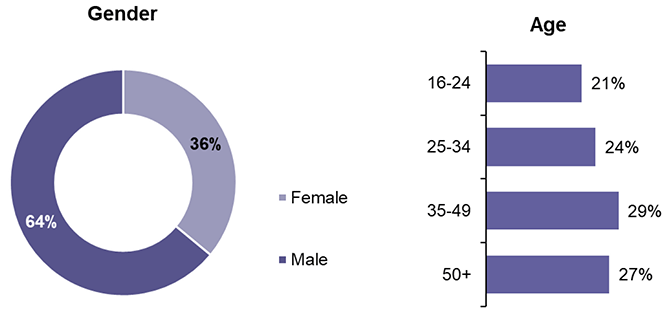
Image description:
This figure shows the age and gender of the 2019 cohort - 64% were male and 36% were female, while 21% were aged 16 - 24, 24% 25 - 34, 29% 35 - 49 and 27% 50 and older.
Source: IFF Research telephone survey of FSS customers, H1: Do you identify as…?, H2: Which of the following age bands do you fall into? Base: All 2019 cohort (607)
Compared to the 2018 cohort, there was an increase in participants that fall into the youngest age band of 16-24 years old. A fifth (21 per cent) of the 2019 cohort stated that they were 16-24 years old, up from 16 per cent of the 2018 cohort.
Qualification level
Around three-quarters (77 per cent) of the 2019 cohort had achieved equivalent to National 1-5 or higher, with almost a fifth (18 per cent) having the highest level of qualification of level 8 or above (degree or above, Higher National Diploma, SVQ4 or SVQ5). One in ten (10 per cent) had no formal qualifications, as shown in Figure 2.2. The qualification levels of the 2019 cohort were broadly in line with the 2018 cohort.

Image description:
This figure shows the qualifications achieved by the 2019 cohort. 38% achieved National 1 - 5 or equivalent, 21% Highers or Advanced Highers or equivalent, 18% LEVEL 8+, 2% another qualification and 10% none of the above or other. An additional 9% said they didn't know and 2% said prefer not to say.
Source: IFF Research telephone survey of FSS customers, H3: What is the highest level of qualification that you have achieved? Base: All 2019 cohort (607)
Female participants in the 2019 cohort were more likely than male participants to be qualified to level 8 or above (23 per cent compared with 15 per cent). There were also some differences by age; those aged over 50 years were more likely to have no formal qualifications (18 per cent) and to have achieved national level 1 or 2 as their highest qualification (8 per cent compared with 5 per cent overall). Those in the 2019 cohort youngest age band (16-24 years) were more likely to have achieved national level 4 or 5 (43 per cent compared with 24 per cent overall).
Ethnicity
As shown in Figure 2.3, the vast majority of participants were white (93 per cent) with seven per cent of participants from Black, Asian and Minority Ethnic backgrounds.
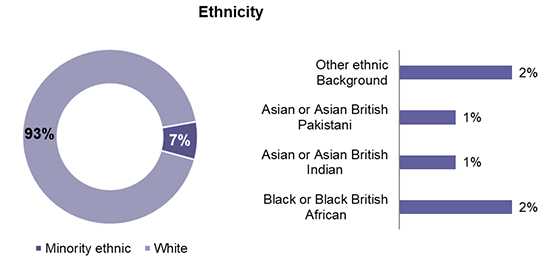
Image description:
This figure shows the ethnicity profile of the 2019 cohort. 93% were white, while 7% were from Black, Asian and Minority Ethnic backgrounds: 2% were Black, or Black British, or African; 1% were Asian or Asian British/Indian; 1% were Asian or Asian British/Pakistani; and 2% were from other ethnic backgrounds.
Source: IFF Research telephone survey of FSS customers, H3: H4_W2. Which of the following best describes your ethnic background? Base: All 2019 cohort who agreed to provide demographic details (582)
Health conditions
In the 2019 cohort, nearly two-thirds (64 per cent) of participants had at least one long term health condition. As shown in Figure 2.4, over a quarter had one health condition (28 per cent) while one-in-five (20 per cent) had two conditions. Over a third (37 per cent) of the 2019 cohort had more than one health condition. One in twenty (5 per cent) refused to provide this information.
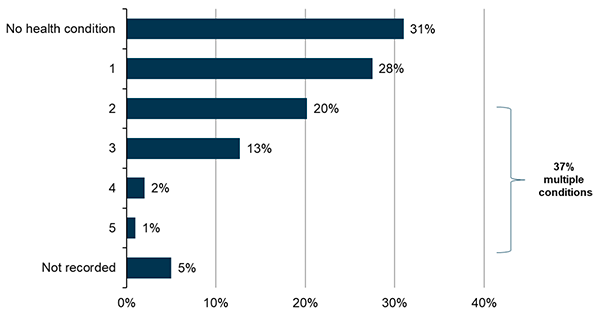
Image description:
This chart shows the number of health conditions reported by the 2019 cohort. 31% reported no health conditions and 28% one condition. Overall, 37% reported multiple health conditions (most commonly 2 and least commonly 5). 5% did not provide this information.
Source: IFF Research telephone survey of FSS customers, Sample information and H4i: Do you have any of the following conditions which have lasted, or are expected to last, at least 12 months? Base: 2019 Cohort (607)
As shown in Figure 2.5, the most common condition among the 2019 cohort was a mental health condition, with over a third (34 per cent) of participants reporting this issue. Long-term illnesses were nearly as common (31 per cent), followed by a learning difficulty (18 per cent) or a physical disability (17 per cent).
Participants were also asked which of the conditions they reported was their main health condition. Also shown in Figure 2.5, mental health conditions (20 per cent) and long-term illness (11 per cent) were the most common form of main condition. One in twenty (five per cent) had a condition that was not listed and a similar proportion (seven per cent) were unable to distinguish which was their main condition.
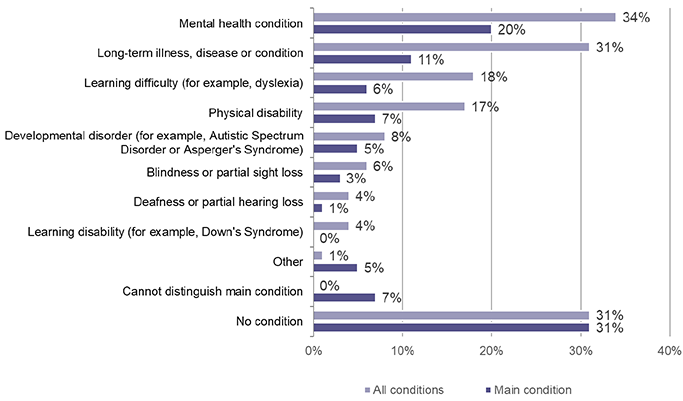
Image description:
This figure shows the health conditions and main health condition reported by the 2019 cohort. The most common conditions reported were mental health conditions (34%), long-term illnesses, diseases or conditions (31%), learning difficulties (18%) and physical disabilities (17%). The same pattern emerged when respondents reported their main condition; 20% said a mental health condition, 11% a long-term illness, 6% a learning difficulty and 7% a physical difficulty. 31% said they had no condition.
Source: IFF Research telephone survey of FSS customers, Sample information combined with H4i: Do you have any of the following conditions which have lasted, or are expected to last, at least 12 months? H4m: And which of those would you consider to be your main health condition or disability? Base: 2019 Cohort (607)
There were some differences between the prevalence of different health conditions amongst participants; the key differences relate to age and employment status:
- Unsurprisingly, age was a key factor affecting both the likelihood of having a health condition and the type of condition experienced. Participants in the 35-49 age group were more likely to have no health condition (38 per cent), while those aged 50 and over were more likely to have a long-term illness (47 per cent) or a physical disability (28 per cent), than other age groups. The youngest age group, 16-24, were more likely than other age groups to have a developmental disorder (21 per cent), while the next youngest, 25-34, were more likely than other age groups to have a mental health condition (43 per cent).
- Another key factor affecting prevalence of health conditions was employment status. This relates to employment status reported by participants at the time of the survey. Participants that were in work were more likely to report no long-term health conditions (40 per cent) than those not in work (26 per cent). Furthermore, participants who were not working were more likely than those in work to have a mental health condition (38 per cent, compared with 29 per cent in-work), a long-term illness (35 per cent, compared with 26 per cent in work), or a physical disability (23 per cent, compared with nine per cent in work).
There were smaller but significant differences by geographical location and gender:
- By gender, women were more likely to report having a mental health condition (43 per cent compared with 29 per cent of men), and men more likely to report a developmental disorder (10 per cent compared with three per cent of women).
- By geographical location, those in Lot 1 - Glasgow were most likely to have no health conditions (46 per cent). Long-term illnesses were more common among participants from Lot 5 - the East (41 per cent) while developmental disorders were more commonly reported among Lot 4 - Forth Valley (21 per cent).
When comparing the profile of the 2019 cohort with participants who joined the service in 2018 (the 2018 cohort), a smaller proportion of the 2019 participants had a health condition (64 per cent reporting at least one condition, compared to 74 per cent of the 2018 cohort). However, those that did were much more likely to have multiple conditions (37 per cent, compared to 16 per cent of the 2018 cohort). The nature of conditions also differed between the two cohorts, with the proportion of the 2019 cohort experiencing a long-term health condition (31 per cent) significantly higher than the 2018 cohort (25 per cent), as was the proportion with a learning difficulty (18 per cent, compared to 13 per cent).
Impact of health conditions
To gauge the impact that health issues had on FSS participants, all respondents who had a health condition or disability were asked about the extent to which it limited their ability to carry out day-to-day activities, either whether they were not limited by it at all, limited a little or limited a lot. Figure 2.6 shows the impact of health conditions for all of the 2019 cohort. Almost half of participants in the 2019 cohort (47%) said they were impacted by a health condition either a little or a lot.
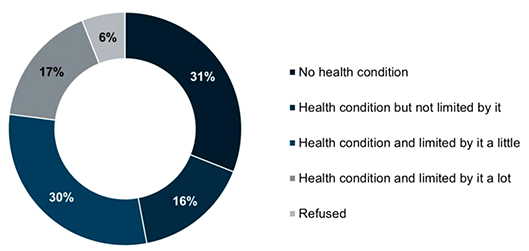
Image description:
This figure shows the extent to which health conditions or disabilities limit participants' ability to carry out day-to-day tasks, based on the full 2019 cohort. 16% said they were not limited by their health condition, while 30% were limited a little and 17% a lot.
Source: IFF Research telephone survey of FSS customers, H4N_W2. Does your health or disability limit your ability to carry out day-to-day activities? Base: 2019 cohort (607)
Figure 2.7 shows the impact of health conditions on participants that had at least one condition. Just under three quarters (74 per cent) reported their health condition limited them to some extent (either a lot or a little), with over a quarter of those with a condition (27 per cent) reporting that it limited them a lot. The remaining quarter (25 per cent) were not limited by their health conditions.
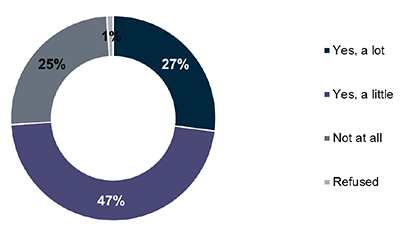
Image description:
This figure shows the extent to which health conditions or disabilities limit participants' ability to carry out day-to-day tasks, based on those with at least one health condition. 27% said it limits them a lot, 47% a little and 25% not at all.
Source: IFF Research telephone survey of FSS customers, H4N_W2. Does your health or disability limit your ability to carry out day-to-day activities? Base: 2019 cohort with health condition (403)
The impact of their health condition was broadly similar across the 2018 and 2019 cohorts. Around half (52 per cent) of 2018 participants reported a little impact on day-to-day activities and 29 per cent reported that their health condition impacted them a lot. There were, however, more participants in the 2019 cohort that were not impacted by their condition (25 per cent) than in the 2018 cohort (17 per cent).
Priority family groups
Scottish Government has identified a number of priority family groups, these are family types that have a higher than average risk of child poverty. These include lone parents, young parents (under 25 years old), parents from minority ethnic groups, parents with a disability / health condition, families with three or more children, and families with a child under 12 months of age. There is a desire to further understand the impact of employability support on tackling child poverty, so it is key that FSS reaches these parents.
Just over a fifth (21 per cent) of the 2019 cohort were identified as part of a priority family group, most commonly, these were parents with a disability / health condition (13 per cent). Around one in ten (11 per cent) of the cohort were lone parents, one in twenty (5%) were large families and four per cent were parents from minority ethnic groups. This is shown in Figure 2.8.
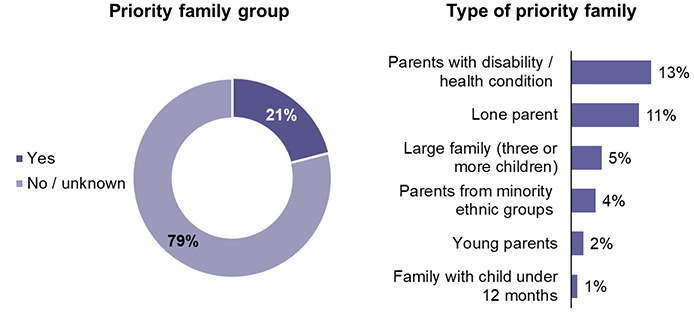
Image description:
This figure shows priority family groups as a proportion of the 2019 cohort. 21% of the cohort were identified as a priority family group. These were parents with a disability or health condition (13%), lone parents (11%), large families (5%), minority ethnic parents (4%) young parents (2%) and families with children under 12 months (1%).
Source: IFF Research telephone survey of FSS customers, Base: All 2019 cohort (607)
Employment history
Participants were asked about their employment history in the five years prior to receiving support from FSS. Almost six in ten (58 per cent) of the 2019 cohort who were not in work at the point of the survey had spent some time in the past five years in employment, either paid or unpaid. These participants had generally not spent long in their most recent role. Almost half (47 per cent) of those who had been in work in the previous five years, had spent less than six months in their most recent role. A further 28 per cent spent between six months and a year in that role.
Considering the 2019 cohort as one,[5] Figure 2.9 shows that around a third (34 per cent) of the 2019 cohort had been out of work for whole five-year period prior to receiving support from FSS. Just five per cent had been in work for the whole duration and 11 per cent had been out of work for up to six months. Figure 2.9 also shows when the 2019 participants had stopped working in their most recent role. Three in ten (30 per cent) stopped working in their most recent role over five years ago, and for one in ten (10 per cent) it was between one and two years since they had last been in work.
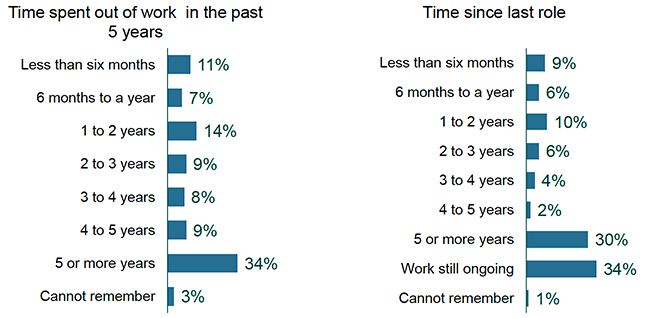
Image description:
This figure shows the time spent out of work and time since last role amongst the 2019 cohort. 34% spent 5 or more years out of work, 14% 1 to 2 years and 11% less than six months. Between 7% - 9% had spent 6 months to a year or between 2 to 5 years out of work. Additionally, 30% said it was 5 or more years since their last role, while 10% or less said it was between 0 and 5 years. 34% said work was ongoing.
Source: IFF Research telephone survey of FSS customers, B3: In total over the past 5 years prior to receiving support through the Fair Start Scotland service approximately how long have you spent out of work? B4: How long ago did you stop working in your most recent role? Base: All 2019 cohort (607)
Both the time that participants had spent out of work and the length of time since their last role was correlated with qualification level. Participants in the 2019 cohort with a degree level qualification or above were less likely to have been out of work for five or more years (20 per cent) and to have stopped working in their most recent role five or more years ago (19 per cent), compared to participants overall.
Health condition also played a role in employment history, with participants who had not worked in the last five years more likely to say that they were impacted by their health condition a lot (37 per cent compared with 22 per cent who had worked in the last five years).
The 2018 cohort was broadly similar to the 2019 group in terms of their employment history, which suggests that FSS is consistent in its referral approach. However, the 2019 cohort were less likely to have been out of work for the five years prior to joining FSS (30 per cent compared with 36 per cent of 2018 cohort) suggesting they had slightly higher engagement with work prior to joining.
Contact
Email: socialresearch@gov.scot
There is a problem
Thanks for your feedback